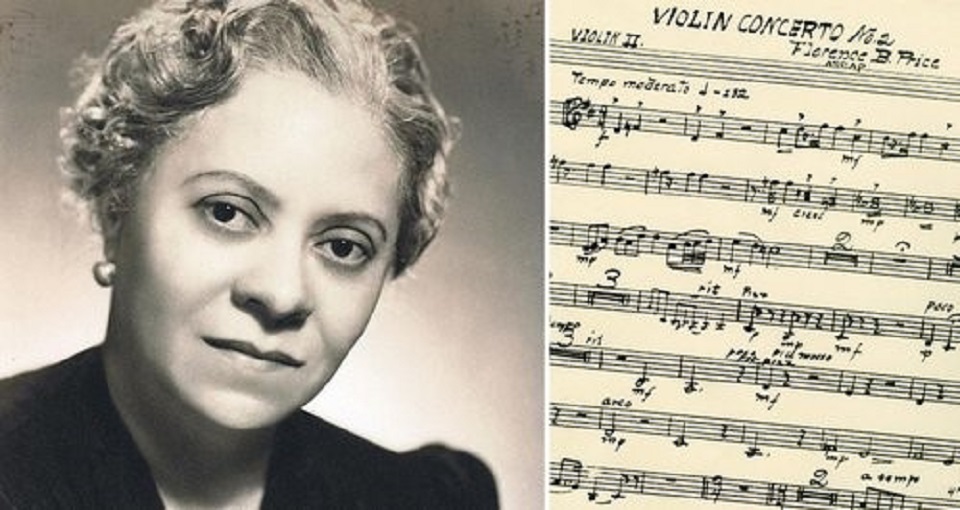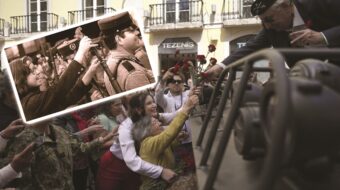
Having earlier reviewed Randall Goosby’s CD of violin music highlighting the Black experience, and another featuring Black composers, including Florence Price, we come now to the most recent release—the same violinist with a program including the Max Bruch Violin Concerto and not one but two violin concertos by Price, who is undergoing a major and long overdue critical rehearing.
“I wanted to be the one to share these pieces in this way for the first time,” says the violinist. It’s the first commercially recorded release of these large orchestral works on a major label. Once again, as with the Price symphonies, the musicians are The Philadelphia Orchestra under the baton of its music director, since 2012, Yannick Nézet-Séguin. The Québécois conductor and pianist also directs the Orchestre Métropolitain of Montréal and New York’s Metropolitan Opera. That earlier symphonic recording won the Grammy Award for Best Orchestral Performance.

Bruch’s concerto is a standard concert hall visitor. Every world-class violinist has it in their repertoire. The term “warhorse” was coined for a work such as this, a 19th-century showpiece that audiences never tire of hearing. Goosby dispatches it with flair, professional competence and pride. It’s only a matter of taste if you happen to prefer this new interpretation over any of the others available, but it’s certainly worth checking out. The only reason orchestra presenters might start programming the Bruch a little less going forward is if there are other violin and orchestra works that might offer audiences something else, fresh and different, to perk up a season. And that’s where the other pieces on this CD come in.
Florence Price (1887-1953) received her musical training at the New England Conservatory of Music (1903–06), the University of Chicago, and the American Conservatory of Music. Despite great odds against her as a woman and an African American, she persevered, garnering a number of commissions and prestigious performances. Her fame was fleeting, however, and apart from a few songs and arrangements kept alive by some African-American singers, much of her output was forgotten. Some major works, including her second symphony, are considered lost. Her rediscovery has been slow but sure.
Price wanted to make her mark in the classical music world, but not only by exploring the rich vein of African-American genres—spirituals, gospel, blues, jazz, vaudeville, etc. She did draw on those sources but not exclusively. Her orchestral models were Tchaikovsky, Brahms, Dvorák. The banjo rhythm or blue note will certainly be heard in her work, but she no doubt felt that orchestra audiences would rather be coddled by the esthetic of those great composers of the past somewhat updated in her own language. She cannot be considered a “modern” composer in the school of the Bauhaus or the twelve-tone serialists of her day or even the French impressionists. She remained a “Romantic” who apparently never deviated from her musical convictions to please critics and academics howling for the latest, most boundary-breaking angular sonorities. In that rejection of the new for the sake of novelty, she certainly had good company—American composers such as Ferde Grofé or Leroy Anderson or the British Albert Coates.
“Her writing is not always the most accessible upon the first hearing,” Randall Goosby says, “and this is in part due to her synthesis of clearly defined styles. She switches between soulful, traditional American folk melodies, and modern takes on late-Romantic harmonic idioms. So, it was a bit daunting to figure out the music, what it is, where it’s going—and then of course to try to put my own voice into it.
“Also, I think it’s too easy to look at the First Concerto as merely derivative. If you zoom out and look at Price’s life, the places she visited, where and what she studied, I think it’s a perfect example of what makes American music so great. It’s music from another place that has gone through the wringer and come out somewhere else. All the influences together make up this one thing, which is Florence Price.”
The Violin Concerto No. 1 in D, is 25 minutes long. Its first movement, marked moderato, is the longest, at 16:35. Its pastoral melodies summon sentimental memories of a happy, trouble-free, country childhood. I couldn’t help thinking of the Edvard Grieg music that accompanied the old television series I Remember Mama. The violin introduces melodic themes that are soon picked up by strings, flute and bassoon. Birds chirping along meandering wooded paths are the images that come to mind. The African-American content is minimal, and the showmanship for the solo player is kept under control. Only in the last couple of minutes of the movement does the coda raise expectations of something musically more important than what we’ve heard so far, although of course it has been earned precisely by what has come before. The movement has a dramatic finale.
In the second movement, andante, at 7:12, we get a tentative bluesy overcast, as though the composer is reticent to get too “ethnic.” In its lovely song-like turns of phrase one can almost hear unsung lyrics from standard old popular melodies—Stephen Foster, perhaps.
I couldn’t help thinking of the popular Samuel Barber violin concerto once the third movement, allegro, at 5:12, began. Like that work, this one starts off languorously, taking its time, spinning intoxicating reveries for two movements, then breaks out into a virtuosistic skipping tune with ear-catching intervals, not quite so diabolical as the Barber, but with a huge buildup toward the end, when Price gives us a sweet, soft landing. The playing of the orchestra under Nézet-Séguin is subtle, providing just enough, not too much of an aural platform for the soloist to shine on.
The Second Concerto dates from more than a decade later. It’s shorter, at 15:52, and in one unmarked movement. By now Price has somewhat loosened her bonds to her classical models, and she feels freer to roam wherever her spirit guides take her. It’s no more “modern” than the first concerto, but she explores her own harmonic language in what sounds like a free-form organizational program. Wholly comfortable in her chosen idiom of “light classics,” she is perfectly content to dispense with the tortured soul-searching of the great Romantics. After 15 minutes of charming note-spinning, she reaches out with a final flourish that seems to say, “I have nothing more to add. This is the end.”

A bonus track on the album is Price’s violin-piano piece Adoration, a sensuous stunner with a vaguely “spiritual” tone that clocks in at under four minutes. Goosby includes this piece on his Roots album, but here it appears in a new version by Jim Gray accompanied by the strings of the orchestra. The solo violin luxuriates upon a comforting pillow of soft string sound.
Why pair Price’s all too unfamiliar work with a standard like the Bruch concerto? Partly, as Goosby says in the program note, to display her in the context that formed her—and that formed him, too. His musical lineage is equally the great European classics, which are always going to be his bread and butter as a concert artist, and the African-American culture of which he is a part. (His mother is Korean, so I wouldn’t be surprised if he might one day explore that part of his heritage as well.)
Much to be grateful for here, especially for a conscious young multi-racial artist who is making a great career for himself with important discoveries for us all.
Max Bruch/Florence Price Violin Concertos
Randall Goosby and Yannick Nézet-Séguin
The Philadelphia Orchestra
Decca 485 4234, 2023
We hope you appreciated this article. At People’s World, we believe news and information should be free and accessible to all, but we need your help. Our journalism is free of corporate influence and paywalls because we are totally reader-supported. Only you, our readers and supporters, make this possible. If you enjoy reading People’s World and the stories we bring you, please support our work by donating or becoming a monthly sustainer today. Thank you!












Comments